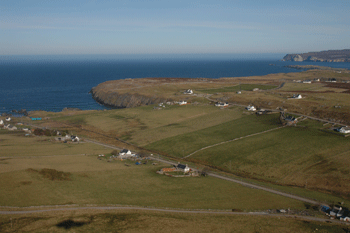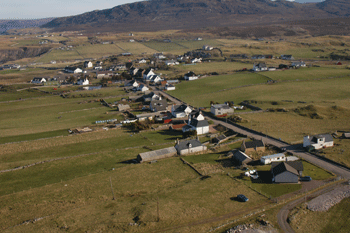
Mackay Country
Dùthaich Mhic Aoidh
An area in North-West Scotland of natural unspoiled beauty, rich in heritage & history
Durness
The Most North Westerly Village On Mainland Britain
This is the centre of the ancient lands of Clan MacKay and the most north westerly community in mainland Britain. It is an ideal place to explore the solitude of the highlands, to watch the varied wildlife and birds, or enjoy a spot of fishing or golf. Being on the “corner” of Scotland, Durness makes an ideal base for touring the rest of the north – west highlands, a vast area of outstanding natural beauty

Durness marks the point at which the main coast road from Thurso via Tongue turns left and heads south towards Scourie and Kylesku. Durness is now one of the few remaining places of any size in mainland Scotland that you can only access by single track road. The road south was completed in 1893, and from the following year there was a daily coach connecting Durness with the railway station at Lairg, some sixty miles to the south east. The name Durness could be from the Norse Drya-ness meaning Deer Cape or Deer point and has been referred to as an oasis in a barren land, the last resort or the last outpost. It stands slightly proud from the sea with sandy beaches and rocky coves. Durness village provides 2 grocery shops, a campsite overlooking Sango Bay and sandy beaches at Balnakeil, Sango, Sangobeg and Ceannabeinne and a popular nine hole golf course. Durness is a remote and scattered crofting township in northwest Sutherland, lies to the northwest of Loch Eriboll and 13 miles (21 km) northeast of Laxford Bridge. A crofting village spread out along the coast, Durness is basically a string of hamlets. The area offers unlimited sea trout fishing opportunities for the visitor as well as a walking network for all abilities

Durness is the most northwesterly village on Mainland Britain and the centre of the ancient lands of Clan Mackay. It is an ideal place to explore the solitude of the highlands, to watch the varied wildlife and birds, or enjoy a spot of fishing or golf. Being on the “corner” of Scotland, Durness makes an ideal base for touring the rest of the northwest highlands, a vast area of outstanding natural beauty.
The name Durness could be from the Norse Drya-ness meaning Deer Cape or Deer point and has been referred to as an oasis in a barren land, the last resort or the last outpost. It stands slightly proud from the sea with sandy beaches and rocky coves.
Within the parish boundaries can be found evidence of cave dwellings, stone circles, chambered cairns, 8th century Christian settlement, the Vikings, 18th century architecture, the notorious clearances and the Second World war.
Over 80 townships have made up Durness parish in the past. The village today has several constituents that are identified from the ancient townships. www.durness.org A walking network was designed to take visitors and inform them of the area. The information booklet can be viewed at Durness Walking Network. For its size Durness is an active community with much participation in village events. The small primary school is seen as a central part of the community but as numbers fall to 11 pupils concern is about the future.


“In Durness
The hills are the most
Beautiful thing for miles
And with their snow capped peaks
They stand as proud as 700
Proud men that are winners
And inside their cold shell
A tremendous feeling grows
A happiness that spreads
To every single soul in
The Country of Mackay”
Mark McCowan Durness Primary School
Durness village provides 2 grocery shops, a campsite overlooking Sango Bay and sandy beaches at Balnakeil, Sango, Sangobeg and Ceannabeinne. Durness is a remote and scattered crofting township in northwest Sutherland, lies to the northwest of Loch Eriboll and 13 miles (21 km) northeast of Laxford Bridge. A crofting village spread out along the coast, Durness is basically a string of hamlets. The area offers unlimited sea trout fishing opportunities for the visitor as well as a walking network for all abilities.
Over 80 townships have made up Durness parish in the past. The village today has several constituents that are identified from the ancient townships. Entering the village from the south is Mackay’s, Rooms and Restaurant a shop and a filling station, a minor road turns off to Balnakeil.
Remaining on the A838 through the townships of Durness pass the shops and the area of Sango and Sangomore. Here is the Campsite, restaurant and public bar. The most obvious feature is Sango Bay a popular and easily accessible beach with three inlets.



One of the highlights of the year is the Durness Highland Gathering, which takes place at the end of July
www.durnesshighlandgathering.co.uk
Durness sheepdog trials in September and the Cape Wrath Challenge in May. www.capewrathchallenge.co.uk


Durness’ Tourist Information and Visitor Centre is open April-October. The Durness Visitors Centre is set overlooking Sango Bay practically in the centre of the village and about 3oo metres from the village square. The building houses the local service point for the Highland Council, tourist Information and Countryside Ranger. It is staffed by local people and is open for different and various lengths of times of day all year. The displays are informative; including a geological standing stone exhibit out side the centre. This caused local consternation when it first appeared and the spirit was captured by Dottie Mackay in her poem.
The Stones of Sangomore by Dottie Mackay
Even in those modem “High-Tec” times, we still don’t understand,
The mearsuing of the Standing Stones that grace our ancient land,
But now to add to the great mystery, of those monuments of yore,
Comes the miraculous appearance of ‘The Stones of Sangomore.”
Now while to simple crofting folk they may seem a costly blunder,
There’s little doubt in years to come, experts will gaze in wonder,
But as they earnestly debate the When? – The why? – The How?
They’ll be just as B——y baffled as the folk who live here now.
Some talk of devil worship, and Druid Rituals in the nude,
And fear the stones will bring decline in moral rectitude,
But when asked Old John the Crofter said “Och I’ve seen it all before,
Did it myself when 1 was young, chase many a bird, round the rocks of Sangomore”
The Anti Quarry folk are happy, for its better far they say,
To see new rocks being imported than the old ones taken away,
But their opponents smile, and take the view, that from the Sango Site,
Ian Wilson can have loads of stones with no need to dynamite.
Now Iris and Dotty are both bound to “Have it Made”
As they sell their “Sango Souvenirs” to a growing tourist trade,
And as Colin Coventry escorts folk around, he’ll state it in his view,
That the Stones hold much more magic than the famous “Cave of Smoo.”
When the “Top Brass of N.A.T.O.” decide to hold an exercise,
They’ll be danger for ‘Low Flying Jets’ that streak across our skies,
For where before they saw Meall nan Cra, and the Hill of Ceannabeinne,
Its now the Stones of Sangomore that will fill the radar screen.
The collies from each croft around will gather at the site,
And the “Inviting Stones of Sangomore” will view with great delight,
And when nature calls our canine friends will bark aloud in glee,
For a stone comes in very handy in a land without a tree!
A local crofter who’s been known to take a dram or two,
May shake his head at what he sees as he staggers home from Smoo,
Where he used to see pink elephants, his befuddled brain will find,
Great heaps of rocks at Sangomore, when he’s stoned out of his mind.
There’s a worry over graffiti, and what some lager -drinking lout,
May spray made words on -” Rural Framework”- or “Keep White Settlers Out’
But if the hooligans won’t listen to the save our “Save our Stones Appeal”
Then we’ll have to get security from the “Fence at Balnakeil’
Archaeologists, in future years will ponder o’er the site
And use carbon dating methods on the heaps of seagull sh—e
Then scrape away the moss and lichen to decipher words beneath,
That say “There’s free drams at the Oasis if you vote for Francis Keith”
Some say there’s no need to go to see the Coliseum in Rome,
Or to travel out to Egypt when we’ve got pyramids at home,
But local cynics disagree, and want the stones put back,
And denounce poor David Richardson and Invergordons Jamie Jack
But the Tourist Board is happy, and say with stones like these,
There’s no need to visit Callanish in the far off Hebrides
And Orkney’s famous Standing Stones, the tourists will ignore,
And flock to Scotland’s new Stonehenge – The Stones of Sangomore.